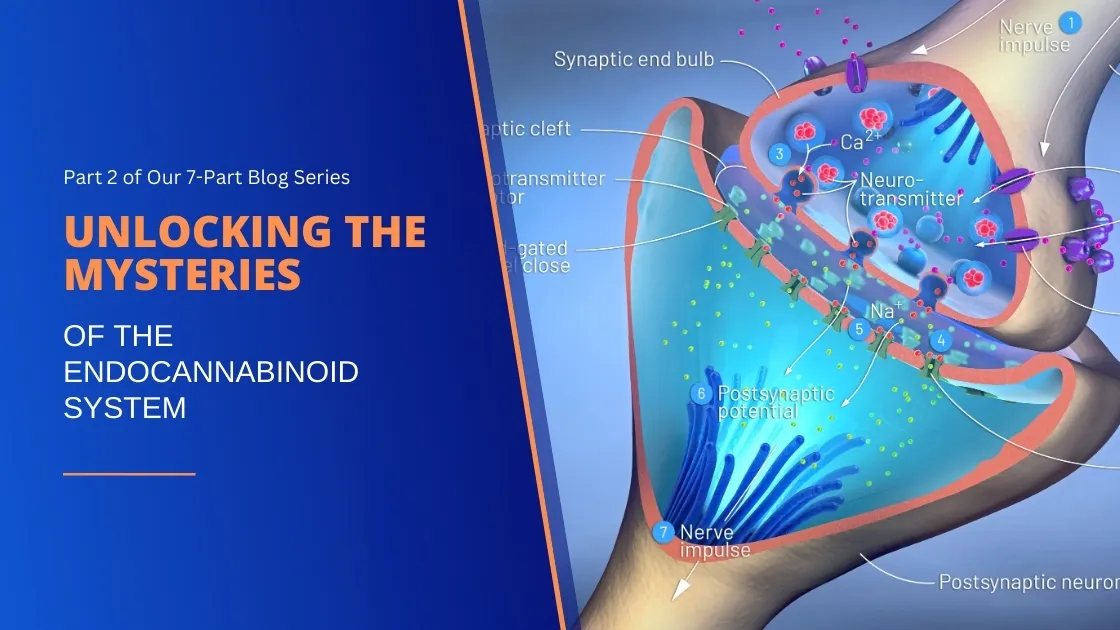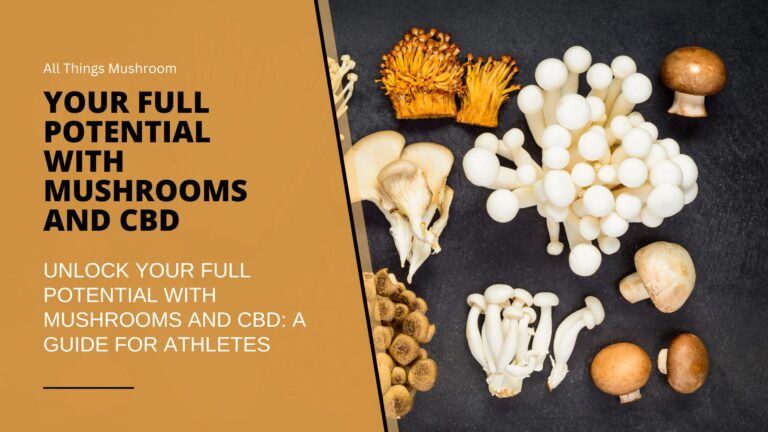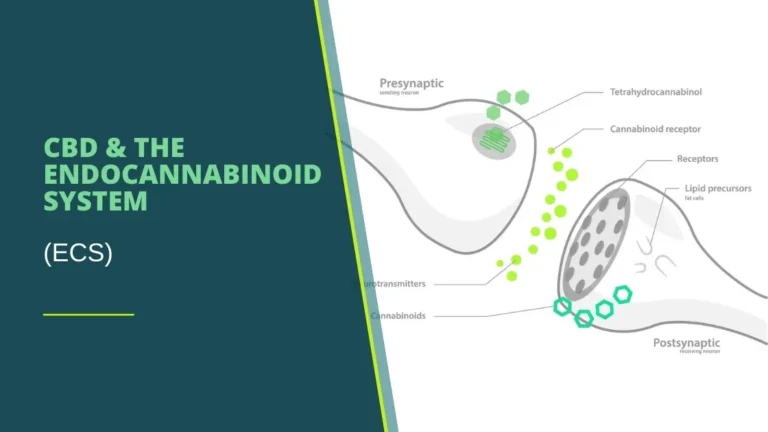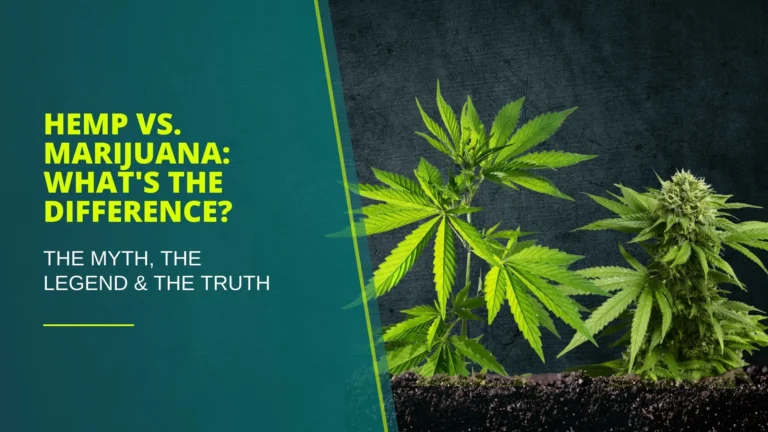Our Bodies ECS
Have you ever wondered how our bodies maintain balance when adapting to various challenges and changes in our daily lives? The answer lies in a system within the human body known as the Endocannabinoid System. Today we embark on a journey to uncover the intricacies of the Endocannabinoid System (ECS), unraveling its significance in our health and well-being, exploring how Endocannabinoid System interacts with compounds like CBD. In this seven-part blog series, we look at the science, functions, and potential of this regulatory network that plays a vital role in maintaining equilibrium within us.
A Look Back in Time: Unveiling the Endocannabinoid System
Depending on your perception of time, the Endocannabinoid System is a recent discovery in biology and medicine. It began with the investigation of the psychoactive effects of cannabis, specifically the compound delta-9-tetrahydrocannabinol (THC), which is one of the main cannabinoids responsible for the “high” associated with marijuana use.
1960’s
In the 1960s when Israeli scientist Dr. Raphael Mechoulam and his colleagues made the first break through when they isolated and synthesized THC. Their work allowed for the study of THC’s effects on the human body.
1980’s
Researchers began to suspect that THC did not solely interact with receptors in the brain but that the body might have its own natural compounds (endocannabinoids) and receptors that interacted with THC.
1990’s
The first endocannabinoid, anandamide, was discovered in 1992 by Dr. Raphael Mechoulam’s team, and the second endocannabinoid, 2-arachidonoylglycerol (2-AG), was identified shortly after. This discovery over 30 years ago marked the beginning of our understanding of the Endocannabinoid System.
The Endocannabinoid System: Our Body’s Master Regulator
Regulating Homeostasis
The Endocannabinoid System plays a pivotal role in maintaining balance and stability within the body, a state known as homeostasis. Homeostasis is your body’s thermostat that ensures essential factors are regulated such as body temperature, blood pressure, pH levels, and the concentration of various substances remain within a constant and healthy range. It helps regulate various physiological functions, ensuring that they operate within healthy parameters.
Adapting to Changes
The Endocannabinoid System helps the body adapt to both internal and external changes and challenges. When we have an imbalance or a stressor, the Endocannabinoid System can initiate responses to restore the body to physical balance bringing us to a calm state of mind.
Influence of Various Functions
The Endocannabinoid System has a significant reach, affecting processes like pain perception, mood, sleep, appetite, immune responses, inflammation, and the list goes on. This makes Endocannabinoid System a key MVP in overall health and well-being.
Therapeutic Potential
The discovery and research into the Endocannabinoid System have led to the development of medications and therapies that target its components. For example, there are medications designed to manage pain, seizures, or anxiety by interacting with the Endocannabinoid System.
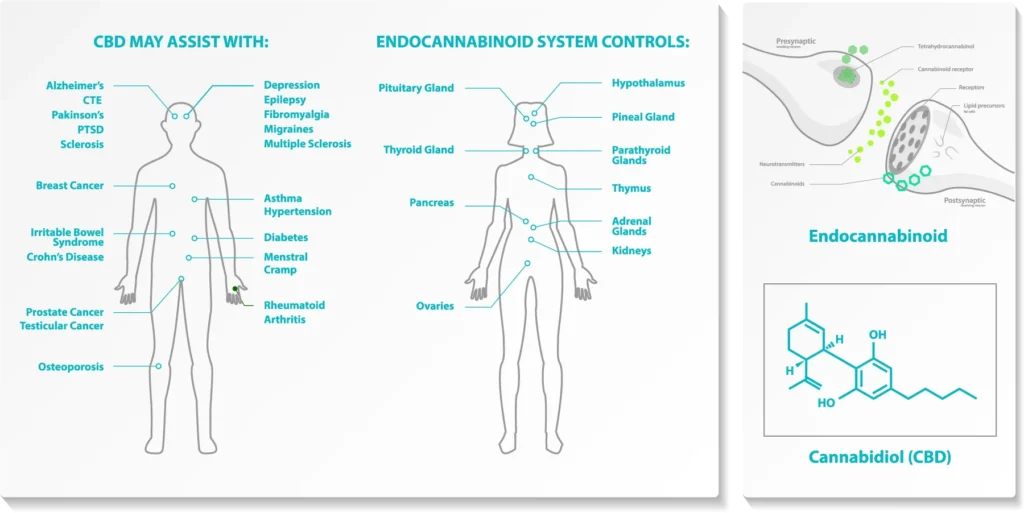
Unveiling the Key Players: Endocannabinoids, Receptors, and Enzymes
Cannabis Research
Unveiling the Endocannabinoid System has revolutionized our understanding of human balance. It explains how our bodies respond to internal and external changes, and sheds light on the diverse effects of cannabis and its compounds, like CBD and THC. This discovery holds immense potential, not only for advancing human biology research but also for developing therapies and treatments for various health conditions. Fueled by this knowledge, scientists are actively exploring the medical applications of cannabinoids, leading to the creation of both natural and synthetic cannabis-based treatments.
The Endocannabinoid System is a complex and essential regulatory system within our bodies that plays a crucial role in maintaining balance and homeostasis. It is named after cannabinoids, the natural compounds found in the cannabis plant, but the human body produces its own cannabinoids, known as endocannabinoids. The Endocannabinoid System consists of three main components:
Endocannabinoids
- Natural cannabinoids produced by the body. The two most well-studied endocannabinoids are anandamide and 2-arachidonoylglycerol (2-AG). Endocannabinoids are created when your body needs them and act like messengers, transmitting signals throughout the Endocannabinoid System to help regulate various functions.
Receptors
- The Endocannabinoid System has two primary types of receptors: CB1 receptors, primarily found in the brain and central nervous system, and CB2 receptors, primarily located in the immune system and peripheral tissues. These receptors are like locks on the surface of cells, and endocannabinoids act as keys that can fit into these locks. When an endocannabinoid binds to a receptor, it triggers a response that helps regulate various physiological processes.
Enzymes
- Enzymes are responsible for the breakdown of endocannabinoids once they have completed their tasks. Two key enzymes involved in this process are fatty acid amide hydrolase (FAAH), which breaks down anandamide, and monoacylglycerol lipase (MAGL), which breaks down 2-AG. This ensures that endocannabinoid signaling is tightly regulated.
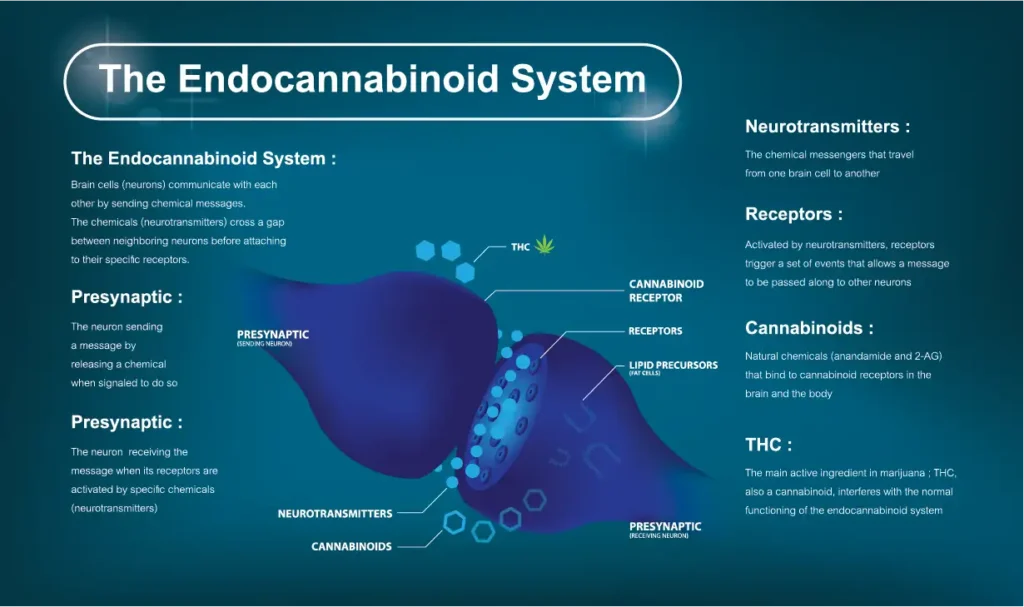
The ENDOCANNABINOID SYSTEM has influence on various bodily functions, including:
Pain Perception
The ECS is natural pain regulator that influences the perception of pain and helps regulate the body’s pain responses.
Appetite & Digestion
The ECS System influences hunger, appetite, and the digestive processes.
Inflammation
The ECS System helps to regulate inflammatory responses in the body.
Mood & Emotions
The ECS System plays a significant role in regulating mood, stress, and emotional responses.
Sleep
The ECS System helps regulate the sleep-wake cycle, contributing to healthy sleep patterns.
Immune Function
The ECS System is involved in modulating the immune system’s responses.
Neuroprotection
The ECS System influences hunger, appetite, and the digestive processes.
Reproductive Health
The ECS System has effects on reproductive processes and fertility in both males and females.
Understanding the CB1 & CB2 Receptors
The Endocannabinoid System is a dynamic networking system that constantly strives to keep our body in a state of balance. When there are imbalances or disruptions in various bodily functions, the Endocannabinoid System works to restore equilibrium. This intricate network of endocannabinoids, receptors, and enzymes helps explain why cannabinoids like CBD have such diverse potential effects on human health and why they are of growing interest in medical research and wellness practices.
Binding to CB1 and CB2 receptors is a fundamental aspect of how the Endocannabinoid System works, as it mediates the effects of cannabinoids, including endocannabinoids produced naturally by the body and Phytocannabinoids found in cannabis plants like THC and CBD. Here is how the binding process works:
CB1 Receptors
Location: CB1 receptors are primarily found in the brain and central nervous system, although they can also be present in some peripheral tissues.
Effects: Activation of CB1 receptors can lead to various effects, including altered perception, mood changes, and pain regulation. These receptors are heavily associated with the psychoactive effects of cannabinoids like THC.
Binding: When a cannabinoid (either endocannabinoid or phytocannabinoid ) encounters the CB1 receptor, it acts like a key fitting into a lock. This binding triggers a signaling cascade that can result in changes in neurotransmitter release and neuronal activity. For example, THC binds to CB1 receptors in the brain, leading to euphoric and psychoactive effects.
CB2 Receptors
Location: CB2 receptors are primarily found in the immune system and peripheral tissues, such as the spleen, tonsils, and cells related to the immune response.
Effects: Activation of CB2 receptors is associated with regulating immune responses, reducing inflammation, and potentially influencing pain perception. These receptors are not typically associated with the psychoactive effects of the THC cannabinoids.
Binding: Like CB1 receptors, when a cannabinoid comes in contact with a CB2 receptor, it triggers a signaling process. This process primarily affects immune cells and the body’s inflammatory responses. CBD, for example, interacts with CB2 receptors and may contribute to its anti-inflammatory effects.
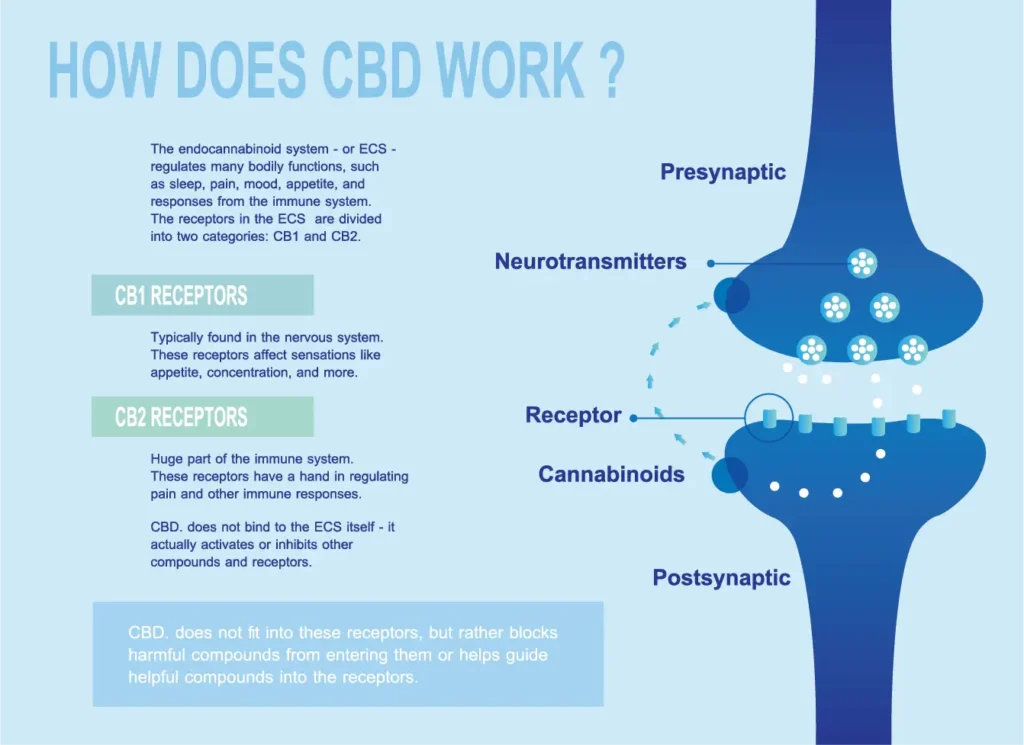
Unlock the Secrets of CBD: Expert Tips and the Latest Trends
It is important to note that the effects of cannabinoid binding can vary depending on several factors, including the type of cannabinoid, the location of the receptors, and the individual’s unique physiology. While the Endocannabinoid System primarily relies on endocannabinoids like anandamide and 2-AG for normal function, Phytocannabinoid s like THC and CBD can also interact with these receptors, influencing various physiological processes.
The balance and regulation of cannabinoid binding are essential for maintaining homeostasis (internal balance) in the body. Disruptions in this balance, whether due to excessive cannabinoid consumption or other factors, can lead to various effects, including changes in mood, cognition, and physical sensations.
Endocannabinoids are produced in the body through a process that involves specific enzymes. Think of the body as having tiny little workers inside, and their job is to make special things called endocannabinoids. These endocannabinoids are like little messengers that help your body work correctly.
Starting with Precursors: Endocannabinoids are made from fatty substances called lipids. These lipids are already present in your body, and they serve as the starting materials for endocannabinoid production.
Enzyme Activation
When your body needs an endocannabinoid to help with something like pain, stress, or inflammation, special enzymes are activated. These enzymes are like little workers that do chemical jobs in your body.
Endocannabinoid Creation:
These enzymes work on the fatty lipids and transform them into endocannabinoids. It’s a bit like baking cookies with a recipe – the enzymes follow specific instructions to create the endocannabinoid.
Travel to the Target
Once the endocannabinoid is made, it travels to where it’s needed in your body. It acts like a messenger, telling your body to do something to make you feel better. For example, it might help reduce pain or calm stress.
Feedback Loop
After the endocannabinoid has done its job, other enzymes come in to clean up and get rid of the endocannabinoid. This keeps everything in balance and prevents you from feeling the effects for too long.
Endocannabinoids are like special messengers your body creates when it needs to fix something, and they help your body work properly to keep you healthy and feeling good.
In Conclusion,
We have taken the next step in our journey into the heart of the Endocannabinoid System in this second installment of our seven-part blog series. The Endocannabinoid System, once a hidden marvel of our biology, has come to the forefront of scientific discovery after the passing of the 2018 farm bill. From its humble beginnings with the exploration of cannabis’s psychoactive effects to the groundbreaking work of Dr. Raphael Mechoulam and his team, our understanding of the Endocannabinoid System has evolved.
This Endocannabinoid System with its receptors, and enzymes, serves as a guardian of balance within our bodies. It regulates everything from pain perception and mood to sleep patterns and immune responses. The Endocannabinoid System’s therapeutic potential has not only led to the development of medications and therapies but also sparked interest in cannabinoids like CBD and THC for various health applications.
As we glance deeper into this remarkable system in the upcoming parts of our blog series, we will uncover even more of its secrets and explore how it interacts with compounds like CBD. So, stay tuned for more insights and revelations about the Endocannabinoid System, its functions, and its profound influence on our health and well-being. To continue this journey and stay updated, on the next blog in our seven-part series CBD and the Endocannabinoid System: Orchestrating Harmony within the human body and be sure to join our blog. Together, we will unlock the mysteries of the Endocannabinoid System and its role in keeping us healthy and feeling good.
Stay Connected





Get in touch today and receive a complimentary consultation.
Sign Up & Stay Connected
Be the first to receive exciting news, educational resources, great tips and special offers.


